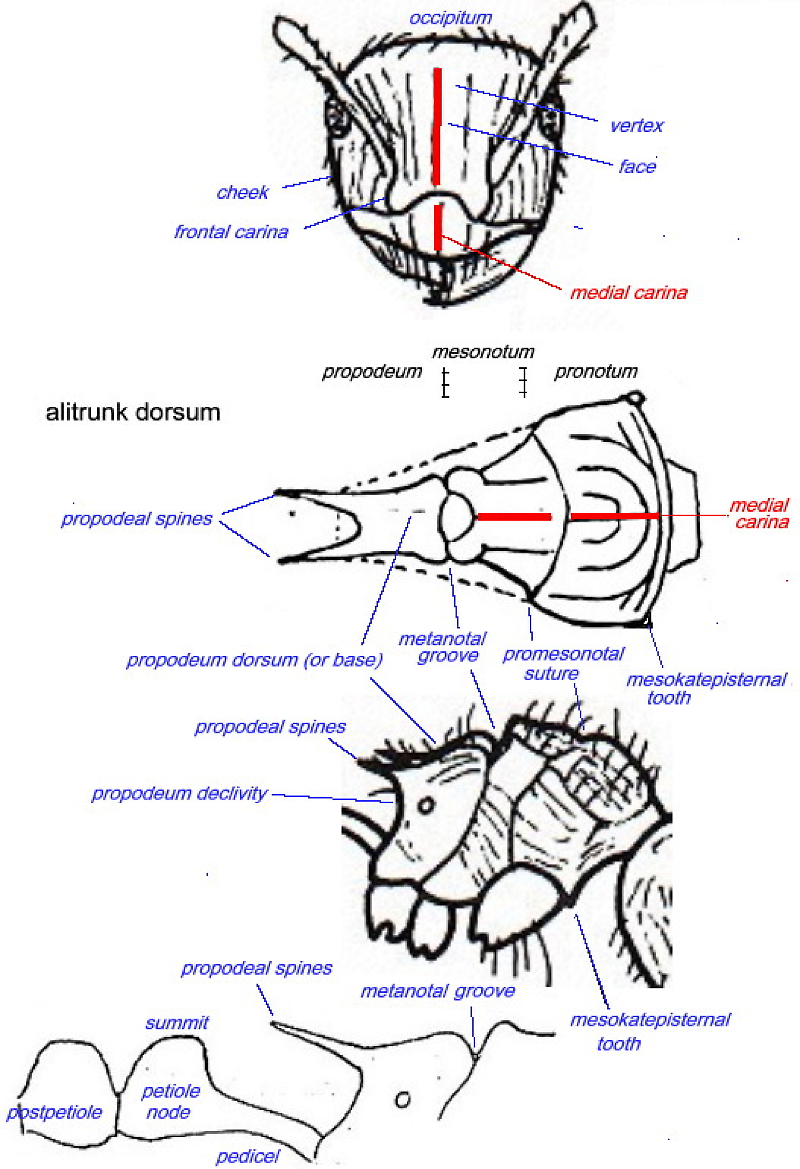SUBFAMILY MYRMICINAE - Genus Myrmicaria
| The Ants of
Africa SUBFAMILY MYRMICINAE - Genus Myrmicaria |
|
| Contents - Myrmicinae - MYRMICINAE Introduction |
Genus Myrmicaria Saunders (1842: 57)In Tribe MYRMICARIINI. No modern taxonomic revision. Diagnostic Features - Antennae 7-segmented and indistinctly clubbed. Frontal carinae widely separated. Eyes lie behind the midlength of the head. Anterolateral angles of the pronotum drawn out into a tooth on each side. Promesonotal suture weakly impressed. Mesonotum bluntly bituberculate behind, sharply angled, posterior portion more or less vertical. Metanotal groove deeply impressed, propodeum bispinose. Petiole with a long anterior peduncle. Sting coarse. Saunders (1842) genus definition (the male of Myrmicaria
brunnea) is at Most members of the genus are savannah living, nesting in the earth and often making sunken runways. The long petiole peduncle enables the workers to hold the gaster pointing almost directly downwards, which provides a quick diagnostic feature for the genus. Longhurst et al. (1983) examined multi-component alarm pheromones from the poison gland secretion of Myrmicaria eumenoides and M. striata. |
|
Most of the following text is my translation of the Genus definition and species descriptions as given by Dr F. Santschi - Santschi (1925c, Révision des Myrmicaria d' Afrique. Annales de la Societé de Belgique. 64 (1924): 133-176). I have added comments from other authors where appropriate - as [Forel, 1911, etc]. |
Taxonomic historyThe initial studies of this genus were confused by the sexual dimorphism (notably the males have 13-segmented antennae; whereas the workers and females have 7-segmented antennae) resulting in the recognition of the ants into the separately named genera. The first male was described as Myrmicaria brunnea from the Indies by Saunders in 1841. Fifteen years later, Frederick Smith described females and workers of three species Heptacondylus arachnoides, H. subcarinatus and H. carinatus from Borneo, Santschi remarks - no doubt because of their seven-segmented antennae. Finally, a decade later, Mayr established the identity of all the forms as belonging to the single genus, Myrmicaria. |
Genus descriptionIn Santschi's words - "It is incontestible that Myrmicaria with its seven-segmented antenna is very aberrant. Such antennal reduction is shared only by the nine-segmented antenna of the fossil genus Ennamerus Mayr, known from Baltic amber. That also is unique and without affiliated genera". He gave the following taxonomic definitions - Generic charactersWORKER - FEMALE - MALE - |

Species descriptions and glossaryUnless indicated, for example as with the descriptions of Wheeler (1922), the species descriptions are my translations of those given (in French) by Santschi. His benchmark species for the descriptions is natalensis and he often refers back to that species in making comparative statements.NOTE - In translating the French, I have used the terms as follows:- arêtes = ridge, edge or flange; arrondi = rounded; atténué = attenutated (less extreme); clair = pale; comprimé = compressed; dressée = raised; effacée = faint (eroded); épais = thick (wide); épinotum = epinotum, modern usage = propodeum; épistome = clypeus ; inermes = rounded, i.e. not a distinct spine; lisses = smooth, polished; rides = rugae (wrinkles), hence rideé = rugose, and ride = ridge; roux = reddish-brown (russet); taille = form (literal translation - figure, cutting, etc. - apparently applied to tailoring); trapue = thick-set (stocky) in build or appearance; dépasse de moitié (plus grand de moitié) = half as big, long again. |
|
Key to workers of African species |
| MYRMICINAE Introduction |
© 2007, 2008, 2012, 2016 - Brian Taylor CBiol FRSB FRES 11, Grazingfield, Wilford, Nottingham, NG11 7FN, U.K. |
href="myrmicaria.htm"